X68000
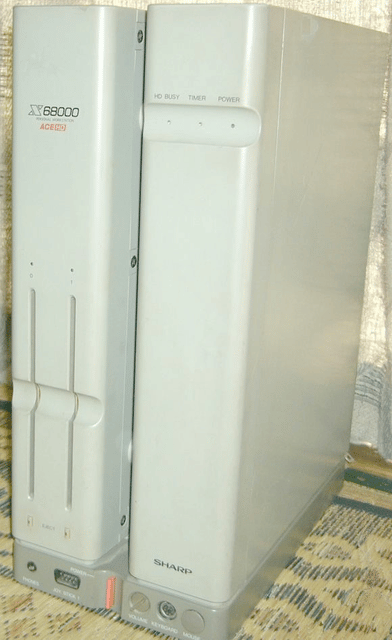
X68000

| Developer | Sharp Corporation |
|---|---|
| Manufacturer | Sharp Corporation |
| Type | Home video game console Home computer |
| Generation | Fourth generation |
| Release date | March 28 1987 (March 28 1987) |
| Discontinued | 1993 |
| Media | Floppy disk |
| Operating system | Human68k, NetBSD, OS-9 |
| CPU | Motorola 68000 family |
| Sound | Yamaha YM2151 OKI MSM6258 |
| Controller input | D-pad, Keyboard, Mouse |
| Predecessor | X1 |
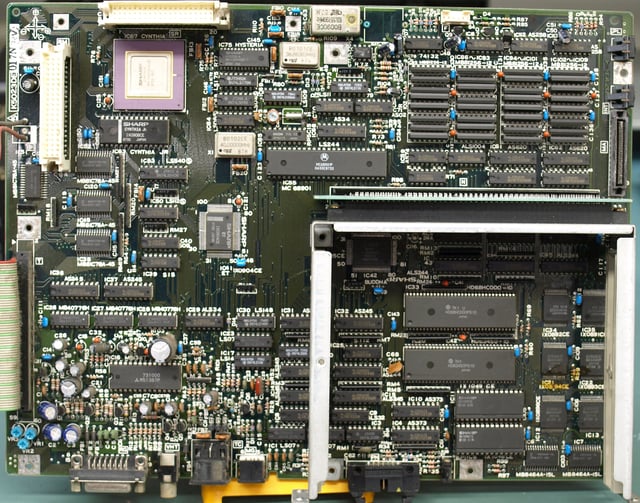
Sharp X68000 Computer Main Processor Board. Original 1987 CZ-600C model
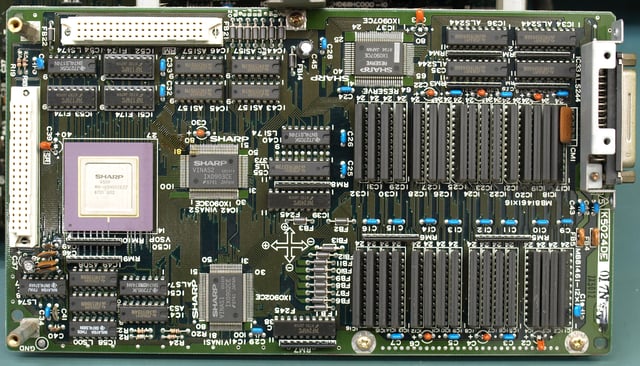
Sharp X68000 Computer Video Board. Original 1987 CZ-600C model
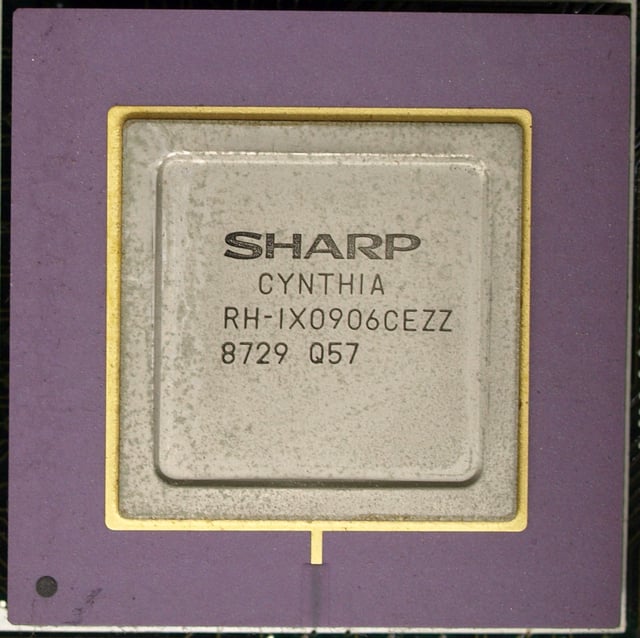
Cynthia Video Sprite Chipset in the Sharp X68000 Computer. Original 1987 CZ-600C model
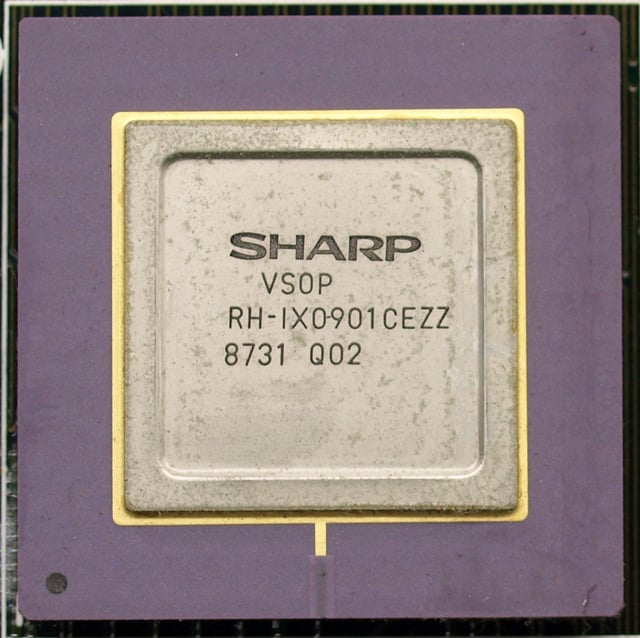
VSOP Video Processing Chipset in the Sharp X68000 Computer. Original 1987 CZ-600C model
The first model features a 10 MHz Motorola 68000 CPU (hence the name), 1 MB of RAM, and no hard drive; the last model was released in 1993 with a 25 MHz Motorola 68030 CPU, 4 MB of RAM, and optional 80 MB SCSI hard drive. RAM in these systems is expandable to 12 MB, though most games and applications do not require more than 2 MB.
| Developer | Sharp Corporation |
|---|---|
| Manufacturer | Sharp Corporation |
| Type | Home video game console Home computer |
| Generation | Fourth generation |
| Release date | March 28 1987 (March 28 1987) |
| Discontinued | 1993 |
| Media | Floppy disk |
| Operating system | Human68k, NetBSD, OS-9 |
| CPU | Motorola 68000 family |
| Sound | Yamaha YM2151 OKI MSM6258 |
| Controller input | D-pad, Keyboard, Mouse |
| Predecessor | X1 |
Operating system
The X68k runs an operating system called Human68k which was developed for Sharp by Hudson Soft. An MS-DOS-workalike, Human68k features English-based commands very similar to those in MS-DOS; executable files have the extension .X. Versions of the OS prior to 2.0 have command line output only for common utilities like "format" and "switch", while later versions included forms-based versions of these utilities. At least three major versions of the OS were released, with several updates in between. Other operating systems available include NetBSD for X68030 and OS-9.
Early models have a GUI called "VS" or "Visual Shell"; later ones were originally packaged with SX-WINDOW. A third GUI called Ko-Window exists with an interface similar to Motif. These GUI shells can be booted from floppy disk or the system's hard drive. Most games also boot and run from floppy disk; some are hard disk installable and others require hard disk installation.
Since the system's release, software such as Human68k, console, SX-Window C compiler suites, and BIOS ROMs have been released as public domain software and are freely available for download.
Case design
The X68000 features two soft-eject 5.25in floppy drives, or in some of the compact models, two 3.5in floppy drives, and a very distinctive case design of two connected towers, divided by a retractable carrying handle. This system was also one of the first to feature a software-controlled power switch; pressing the switch would signal the system's software to save and shutdown, similar to the ATX design of modern PCs. The screen would fade to black and sound would fade to silence before the system turned off.
The system's keyboard has a mouse port built into either side. The front of the computer has a headphone jack, volume control, joystick, keyboard and mouse ports. The top has a retractable carrying handle only on non-Compact models, a reset button, and a non-maskable interrupt (NMI) button. The rear has a variety of ports, including stereoscopic output for 3D goggles, FDD and HDD expansion ports, and I/O board expansion slots.
Display
The monitor supports horizontal scanning rates of 15, 24, and 31 kHz and functions as a cable-ready television (NTSC-J standard) with composite video input. It was a high quality monitor for playing JAMMA-compatible arcade boards due to its analog RGB input and support for all three horizontal scanning rates used with arcade games.
Disk I/O
Early machines use the rare Shugart Associates System Interface (SASI) for the hard disk interface; later versions adopted the industry-standard Small Computer System Interface (SCSI). Per the hardware's capability, formatted SASI drives can be 10, 20 or 30 MB in size and can be logically partitioned as well.
Human68K does not support the VFAT long filenames standard of modern Windows systems, but it supports 18.3 character filenames instead of the 8.3 character filenames allowed in the FAT filesystem. Human68K is case sensitive and allows lower case and Shift JIS encoded Kanji characters in filenames, both of which cause serious problems when a DOS system tries to read such a directory. If a X68000 user restricts himself to use only filenames according to the 8.3 characters scheme of DOS, using only Latin upper case characters, then a disk written on the X68000 is fully compatible with other Japanese standard platforms like e.g. the NEC PC-9800, the Fujitsu FMR and FM Towns computers. The Japanese standard disk format used by the X68000 is: 77 tracks, 2 heads, 8 sectors, 1024 bytes per sector, 360 rpm (1232 KiB).
Expansion
Many add-on cards were released for the system, including networking (Neptune-X), SCSI, memory upgrades, CPU enhancements (JUPITER-X 68040/060 accelerator), and MIDI I/O boards. The system has two joystick ports, both 9-pin male and supporting Atari standard joysticks and MSX controllers. Capcom produced a converter that was originally sold packaged with the X68000 version of Street Fighter II that allowed users to plug in a Super Famicom or Mega Drive controller into the system. The adapter was made specifically so that users could plug in the Capcom Power Stick Fighter controller into the system.
Home arcade
In terms of hardware, the X68K was very similar to arcade machines of the time, and served as the Capcom CPS system development machine. It supports separate text RAM, graphic RAM and hardware sprites. Sound is produced internally via Yamaha's then top-of-the-line YM2151 FM synthesizer and a single channel OKI MSM6258V for PCM. Due to this and other similarities, it played host to many arcade game ports in its day. Games made for this system include Parodius Da! -Shinwa kara Owarai e-, Ghouls 'n Ghosts, Strider, Final Fight, Alien Syndrome, Street Fighter II Dash, Akumajo Dracula (Castlevania in other regions, the X68000 version was ported to the PlayStation as Castlevania Chronicles), Cho Ren Sha 68k (which has a Windows port) and many others. Many games also supported the Roland SC-55 and MT-32 MIDI modules for sound as well as mixed-mode internal/external output.
List of X68000 series
| Release Date | model name | model number | CPU | body | memory | Expansion I/O slot | FDD | HDD | Bundle software | |||
|---|---|---|---|---|---|---|---|---|---|---|---|---|
| color | shape | SASI | SCSI | size | ||||||||
| 1987/03 | X68000 | CZ-600C | Hitachi HD68HC000 10 MHz (Motorola 68000 clone) | Gray/Black | Tower | 1MB | 2 | 5¼ ×2 | o | Human68k ver1.0 (OS) Gradius (Game) | ||
| 1988/03 | X68000 ACE | CZ-601C | Hitachi HD68HC000 10 MHz | Gray/Black | Tower | 1MB | 2 | 5¼ ×2 | o | Human68k ver1.01 | ||
| X68000 ACE-HD | CZ-611C | 20MB | ||||||||||
| 1989/03 | X68000 EXPERT | CZ-602C | Hitachi HD68HC000 10 MHz | Gray/Black | Tower | 2MB | 2 | 5¼ ×2 | o | Human68k ver2.0 | ||
| X68000 EXPERT-HD | CZ-612C | 40MB | ||||||||||
| X68000 PRO | CZ-652C | Hitachi HD68HC000 10 MHz | Gray/Black | Horizontal | 1MB | 4 | 5¼ ×2 | o | Human68k ver2.0 | |||
| X68000 PRO-HD | CZ-662C | 40MB | ||||||||||
| 1990/03 | X68000 EXPERT II | CZ-603C | Hitachi HD68HC000 10 MHz | Gray/Black | Tower | 2MB | 2 | 5¼ ×2 | o | Human68k ver2.0 SX-Window ver2.0 | ||
| X68000 EXPERT II-HD | CZ-613C | 40MB | ||||||||||
| 1990/04 | X68000 PRO II | CZ-653C | Hitachi HD68HC000 10 MHz | Gray/Black | Horizontal | 1MB | 4 | 5¼ ×2 | o | Human68k ver2.0 SX-Window ver2.0 | ||
| X68000 PRO II-HD | CZ-663C | 40MB | ||||||||||
| 1990/06 | X68000 SUPER-HD | CZ-623C | Hitachi HD68HC000 10 MHz | Titan Black | Tower | 2MB | 2 | 5¼ ×2 | o | 80MB | Human68k ver2.01 SX-Window ver2.0 | |
| 1991/01 | X68000 SUPER | CZ-604C | ||||||||||
| 1991/05 | X68000 XVI | CZ-634C | Motorola 68000 16 MHz | Titan Black | Tower | 2MB | 2 | 5¼ ×2 | o | Human68k ver2.02 SX-Window ver2.0 | ||
| X68000 XVI-HD | CZ-644C | 80MB | ||||||||||
| 1992/02 | X68000 Compact | CZ-674C | Motorola 68000 16 MHz | Gray | mini Tower | 2MB | 2 | 3½ ×2 | o | Human68k ver2.03 SX-Window ver2.0 | ||
| 1993/03 | X68030 | CZ-500 | Motorola MC68EC030 25 MHz | Titan Black | Tower | 4MB | 2 | 5¼ ×2 | o | Human68k ver3.0 SX-Window ver3.0 | ||
| X68030-HD | CZ-510 | 80MB | ||||||||||
| 1993/05 | X68030 Compact | CZ-300 | Motorola MC68EC030 25 MHz | Titan Black | mini Tower | 4MB | 2 | 3½ ×2 | o | Human68k ver3.02 SX-Window ver3.0 | ||
| X68030 Compact-HD | CZ-310 | 80MB | ||||||||||
| (Cancelled) | Power X (provisional name) | CZ-xxxx | IBM PowerPC 601 66 MHz | Titan Black | Tower | 8MB | 2 | unknown | o | 240MB | SX-Window ver4.0 | |
List of X68000 games
Technical specifications
Processors
Main CPU (central processing unit) X68000 (1987) to SUPER (1991) models - Hitachi HD68HC000 (16/32-bit) @ 10 MHz XVI (1991) to Compact (1992) models - Motorola 68000 (16/32-bit) @ 16 MHz X68030 (1993) models - Motorola MC68EC030 (32-bit) @ 25 MHz
Sub-CPU: Oki MSM80C51 MCU[1]
GPU (graphics processing unit) chipset: Sharp-Hudson Custom Chipset[2][3] X68000 (1987) model - CYNTHIA Jr Sprite Controller, VINAS CRT Controller, VSOP Video Controller, RESERVE Video Data Selector ACE (1988) to X68030 (1993) models - CYNTHIA Sprite Controller, VICON CRT Controller, VIPS Video Controller, CATHY Video Data Selector
Sound chips:[4] Yamaha YM2151: Eight FM synthesis channels Yamaha YM3012: Floating point DAC with 2-channel stereo output Oki MSM6258: One 4-bit ADPCM mono channel @ 22 kHz sampling rate
Memory
ROM: 1 MB (128 kB BIOS, 768 kB Character Generator)
Main RAM: 1-4 MB (expandable up to 12 MB)
VRAM: 1056 kB 512 kB graphics 512 kB text 32 kB sprites
SRAM: 16 kB static RAM
Graphics
Maximum colors on screen: 65,536 (in 512×512 resolution)
Screen resolutions (all out of 65,536 color palette)[4][5] 256×240 pixels @ 16 to 65,536 colors 256×256 pixels @ 16 to 65,536 colors 512×240 pixels @ 16 to 65,536 colors 512×256 pixels @ 16 to 65,536 colors 512×512 pixels @ 16 to 65,536 colors 640×480 pixels @ 16 to 64 colors 768×512 pixels @ 16 to 64 colors 1024×1024 pixels @ 16 to 64 colors
Graphics hardware: Hardware scrolling, priority control, super-impose, dual tilemap background layers,[4] sprite flipping[5]
Graphical planes: 1-4 bitmap planes, 1-2 tilemap planes, 1 sprite plane[5][6] Bitmap planes[1][5] 1 layer: 512×512 resolution @ 65,536 colors on screen, or 1024×1024 resolution @ 64 colors on screen (out of 65,536 color palette) 2 layers: 512×512 resolution @ 256 colors on screen per layer (512 colors combined) (out of 65,536 color palette) 4 layers: 512×512 resolution @ 16 colors on screen per layer (64 colors combined) (out of 65,536 color palette) BG tilemap planes[5][6] BG plane resolutions: 256×256 (2 layers) or 512×512 (1 layer) BG chip/tile size: 8×8 or 16×16 Colors per BG layer: 256 (out of 65,536 color palette) BG colors on screen: 256 (1 layer) or 512 (2 layers), out of 65,536 color palette BG tiles on screen: 512 (16×16 tiles in 256×256 layers) to 4096 (8×8 tiles in 512×512 layer) Sprite plane[1][5][6] Sprite count: 128 sprites on screen, 32 sprites per scanline, 256 sprite patterns in VRAM (can be multiplied up to 512 sprites on screen with scanline raster interrupt method[7]) Sprite size: 16×16 Colors per sprite: 16 colors per palette, selectable from 16 palettes (out of 65,536 color palette) Sprite colors on screen: 256 (out of 65,536 color palette) Sprite tile size: 8×8 or 16×16 Sprite tile count: 128 (16×16) to 512 (8×8) on screen, 256 (16×16) to 1024 (8×8) in VRAM
Other specifications
Expansion: 2 card slots (4 on Pro models)
I/O Ports: 2 MSX compatible joystick ports Audio IN / OUT Stereo scope/3D goggles port TV/monitor Control RGB/NTSC Video Image I/O Expansion (2 slots) External FDD (up to 2) SASI/SCSI (depending on model) RS232 serial port Parallel port Headphone and microphone ports
Floppy Drives: Two soft-eject 5.25″ floppy drives, 1.2 MB each Two 3.5″ floppy drives, 1.44 MB each (compact models)
Hard Disk: 20-80 MB SASI/SCSI (depending on model)
Operating Systems: Human68k (MS DOS-alike developed by Hudson), SX-Windows GUI
Power Input: AC 100V, 50/60 Hz
Weight: ~8 kg (~10 kg Pro)
Optional upgrades
Upgradable CPU:[8] HARP: Motorola 68000 @ 20 MHz REDZONE: Motorola 68000 @ 24 MHz X68030 D'ash: Motorola 68030 @ 33 MHz Xellent30: Motorola 68030 @ 40 MHz HARP-FX: Motorola 68030 @ 50 MHz Xellent40: Motorola 68040 @ 33 MHz 060Turbo: Motorola 68060 @ 50 MHz Jupiter-EX: Motorola 68060 @ 66 MHz Venus-X/060: Motorola 68060 @ 75 MHz
Additional CPU:[8] CONCERTO-X68K: NEC V30 @ 8 MHz, with 512 kB RAM VDTK-X68K: NEC V70 @ 20 MHz, with 2 MB DRAM and 128 kB SRAM
FPU (floating point unit) coprocessor:[8][9] Sharp CZ-6BP1 Sharp CZ-6BP2: Motorola 68881 @ 16 MHz Sharp CZ-5MP1: Motorola 68882 @ 25 MHz Xellent30: Motorola 68882 @ 33 MHz Tsukumo TS-6BE6DE: Motorola MC68882, with 6 MB RAM
Sound card:[8][10] Sharp CZ-6BM1: MIDI card System Sacom SX-68M: MIDI card System Sacom SX-68M-2: MIDI card Marcury-Unit: 16-bit stereo PCM @ 48 kHz sampling rate, 2× Yamaha YMF288 FM synthesis sound chips
Graphics accelerator & sound card: Tsukumo TS-6BGA[11][12][13] Graphics chip: Cirrus Logic CL-GD5434 (1994) VRAM: 2 MB (2048 kB) 64-bit DRAM Color palette: 16,777,216 (24-bit RGB true color depth) and alpha channel (RGBA) Maximum colors on screen: 16,777,216 Maximum resolution: 2048×1024 pixels Screen resolutions (all out of 16,777,216 color palette) 768×512 pixels @ 32,768 to 16,777,216 colors 800×600 pixels @ 32,768 to 16,777,216 colors 1024×512 pixels @ 32,768 to 16,777,216 colors 1024×768 pixels @ 32,768 to 16,777,216 colors 1024×1024 pixels @ 32,768 colors 1280×1024 pixels @ 256 colors 2048×1024 pixels @ 256 colors Graphical capabilities: 64-bit GUI acceleration, blitter, bit blit Audio capabilities: 16-bit stereo PCM @ 48 kHz sampling rate
Hard disk drive storage:[9] Sharp CZ-5H08: 80 MB Sharp CZ-68H: 81 MB Sharp CZ-5H16: 160 MB
See also
X68000's MDX
X1, the predecessor of the X68000